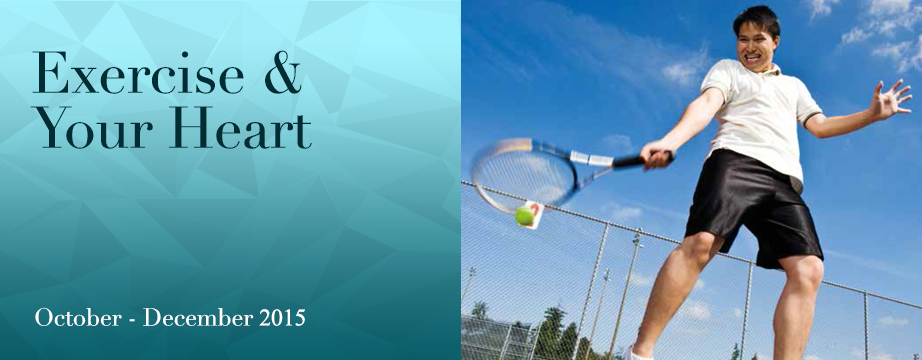
| A commitment to regular and appropriate exercise can help boost your heart health, but be mindful not to put yourself at risk with excessive high-intensity activities. |
| When it comes to heart health, there is a clear distinction between the good guys and the bad. For example, fish oils are a superfood for the heart while trans fat is associated with increased risk of coronary disease. |
| In this cast of good and bad guys, exercise has emerged as the oftentimes-hero and occasional-villain. |
| On the one hand, we now know that regular exercise strengthens the heart and the cardiovascular system. It improves circulation, reduces hardening and narrowing of the blood vessels, and lowers blood pressure, among other benefits. |
| The nett result is that healthy levels of the right exercise can reduce the overall risk of developing heart disease by 50%. |
| On the other hand, every few months we see or hear about seemingly healthy athletes and athletic types succumbing to cardiac arrest because the activity took too heavy a toll on the heart. In fact, it is estimated that there are about three cases of sudden cardiac deaths (SCD) every day in Singapore, with half of these happening to men and women in their late 40s and 50s. Many of these victims had pre-existing coronary heart disease. |
| So how to find the optimal balance? |
| Doing it right |
| Research shows that any activity is better than none. The Health Promotion Board recommends that the average adult Singaporean gets 150 minutes of exercise each week. This should include a combination of aerobic exercise, stretching and strength training, to ensure a total workout. |
| Aerobic exercise, commonly referred to as cardio exercise, refers to activities such as running, jogging, cycling, dancing, walking or any activity that raises your heart rate but not to the extent that you can’t talk while doing it. If you have joint issues, choose a low impact option like swimming. |
| Stretching helps you become more flexible. As a rule, it’s important to warm up before you start and stretch after you finish exercising, though you can also treat stretching as an activity in itself. Be gentle – you should not feel pain if you are doing it right. |
| Strength training is about building muscle strength, especially for seldom-used muscles, and involves weights, resistance bands or your own body weight. Get professional advice on this, as you don’t want to injure yourself with unsuitable weights or find yourself bulking up when you just want to tone and strengthen. |
| If you are trying to lose weight, the intensity of exercise must be increased to achieve adequate caloric burn. But as the intensity increases, so does the risk, and here’s where you need to seek medical advice before you embark. It goes without saying that if you are aiming to challenge yourself with a serious fitness challenge like a marathon or triathlon, you’d best get an updated cardiac assessment from your specialist first. Similarly, if you have an existing heart condition or are recovering from heart bypass surgery, you must consult your specialist before you start on any high-intensity activities. |
| Optimum intensity |
| The target heart rate is a scientific measure used by cardiologists to prescribe exercise intensity. |
| First, your maximum heart rate (MHR) is calculated by subtracting your age from 220. The intensity of exercise is expressed as the percentage of MHR to achieve during exercise. |
| Your heart rate can be determined by counting the number of heart beats in 10 seconds and then multiplying that by six. Nowadays, it is possible to obtain a person’s heart rate by strapping a sensor to the chest. |
| Those who have never exercised before or who are starting again after a long period of inactivity should aim for a rate of 50-70% MHR. If the goal is to lose fat, aim for 60-70% MHR. For endurance training, the aim will be 70-80%. Endurance training includes long-distance running, cycling or swimming. Competitive athletes train at 80-90% MHR, also known as the anaerobic zone. |
| Danger signs |
| If you experience chest pains, giddiness or palpitations during exercise, stop immediately and consult a specialist as soon as possible. These are possible symptoms of an arrhythmia or a problem with the heart’s circulation. |
| Regular physical activity confers many health benefits, but as with everything else in life, moderation is key. |
| Listen to your body, keep your specialist updated and challenge yourself to gradually exercise more. With time, you will find your own personal sweet spot. |
 DR RUTH KAM
DR RUTH KAMCardiologist
MBBS (Singapore)
MRCP (Int Med) (UK)
M Med (Int Med) (Singapore),
FAMS (Cardiology), FRCP (Edin)
Ruth Kam Heart and Arrhythmia Clinic
1 Farrer Park Station Road, #07-11 Connexion
Farrer Park Medical Centre, Singapore 217562
Tel: 6443 0468
www.arrhythmia.com.sg
1 Farrer Park Station Road, #07-11 Connexion
Farrer Park Medical Centre, Singapore 217562
Tel: 6443 0468
www.arrhythmia.com.sg



